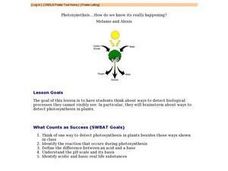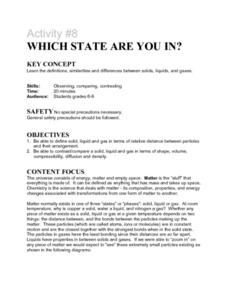Curated OER
Acids and Bases: Their Reactions, Conductivity, Base Indicators and Neutralization Reaction
Students conduct experiments and collect data to determine physical and chemical characteristics of acids and bases.
Curated OER
Finding the Percent of Iron in Lawnsand
In this percent of iron in lawnsand worksheet, students perform a titration of lawnsand using potassium manganate (VII) solution and find the number of moles of iron in the sample. Students use the number of moles to find the mass of...
Curated OER
Extending the Acid/Base Concept
In this acid and base worksheet, students answer 4 questions about the definitions of acids and bases. They illustrate the differences between Arrhenius and Bronsted acids and bases and draw Lewis diagrams for the formation of compounds...
Curated OER
Crystal Growing
Young scholars explore the different phases of a crystal. In this mineral instructional activity students grow their own sugar crystals using a sugar recipe.
Curated OER
Parts of Lab Report Review Sheet
In this lab report worksheet, students answer ten questions by filling in a blank with the appropriate letter that corresponds to the part of the lab. Students determine where data goes, where observations go, where answers to discussion...
Curated OER
Activity #15 The Snowy Christmas Tree
Middle schoolers weigh out the proper amount of silver nitrate and prepare the silver nitrate solution. They observe what occurs when pure copper is added to silver nitrate solution. Pupils determine whether the change in the appearance...
Curated OER
Characteristics of Crystals
In this crystals worksheet, students complete a graphic organizer by filling in the characteristics of the different crystal types including melting/boiling point and electrical conductivity.
Curated OER
How is the Strength of an Acid Determined?
Young scholars study acids and how they can be measured. In this acid lesson students distinguish the properties that create strong and weak electrolytes.
Curated OER
Observing the Effect of a Change in Conditions on a System at Equilibrium by Applying Le Chatelier's Principle
Young scholars describe the Le Chatelier Principle. They participate in an experiment in which they observe the changes in an equilibrium system. They answer discussion questions to end the lesson.
Curated OER
Types of Chemical Reactions
In this chemical reactions worksheet, students fill in 12 blanks, determine if 5 statements are true or false, match 4 types of reactions with their description and solve 2 problems related to balancing equations and chemical reactions.
Curated OER
Chemical Reactions
In this chemical reactions worksheet, students calculate the molar mass and the rate of reaction for the given chemical reactions. This worksheet has 3 problems to solve.
Curated OER
Investigating the Shapes of Covalent Molecules and Measuring their Respective Bond Lengths and Bond Angles
High schoolers will draw Lewis structures of common covalent compounds using a Chem 3D computer program. They will predict the shapes of the molecules, complete a data table, and formulate rules for predicting shapes of molecules. In the...
Normal Community High School
Golf Ball Lab
The first golf balls were made of wood and would only last for a few games. Modern golf balls last a lot longer but they don't float. The presentation provides the directions for a lab to determine the minimum amount of salt needed to...
Curated OER
Review Set
The topics covered in these multiple choice questions are about atomic structure and bonding, state configurations, pressure and solution concentration, and energy graphs. This is a midterm review which could be used with the whole...
American Chemical Society
Using Dissolving to Identify an Unknown
There is a solvent called aqua regis that can dissolve gold! After observing a solubility demonstration, groups receive four known crystals and one unknown. Based on the demo, they design an experiment to determine the identity of the...
National Institute of Open Schooling
Ionic Equilibrium
Scientific studies show the older we get, the more acidic we become. The activity extensively teaches high schoolers about acids and bases. By the end of the 14th installment of 36, they can define and explain three concepts of...
Sunlight Cal-Tech
Chromatography of Plant Pigments
Through a hands-on activity, an acetone-spinach solution is pre-made and learners use this solution to separate the pigments found in spinach using chromatography. The comprehensive resource includes an analysis and conclusion questions.
NOAA
Off Base
How does carbon dioxide affect the world's oceans? The final installment in a series of six lessons has pupils research ocean acidification, then conduct an experiment to witness the delicate balance that exists in our seas. Materials...
Curated OER
Photosynethsis....How do we know it's really happening? - Biology Teaching Thesis
Students think of one way to detect photosynthesis in plants besides those ways shown in class. They identify the reaction that occurs during photosynthesis. Students define the difference between an acid and a base. They identify acidic...
Curated OER
Activity #8 Which State Are You In?
Middle schoolers define, give similarites and differences between solids, liquids, and gases. They compare and contrast a solid, liquid and gas in terms of shape, volume, compressibility, diffusion and density. Pupils classigy common...
Curated OER
Corrosion/Conservation/Preservation
Students examine the reasons why metal corrodes in regard to metal artifacts. In groups, they discover the affects of salt water on metal and compare the type of corrosion found on iron. They also research the types of metal...
Curated OER
Teaching about Increased Conductivity: Are Culverts The Culprits?
Students encounter the complexity of identifying the cause of unusual variations in WOW conductivity data. They propose theories on why there was a sudden increase in conductivity in Ice Lake, Minnesota during July of 1998.
Curated OER
Diffusion through Membranes
Students identify diffusion and its processes through experimentation and calculations. They also use a CBL and conductivity probe to measure the conductivity of various solutions and study the effect of concentration gradients on the...
Curated OER
Moles
In this moles worksheet, students review solubility, moles of solute, molar mass, and colligative properties. This worksheet has 10multiple choice questions and 11 problems to solve.

























